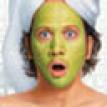- Nega obraza &
telesaZadnje novice
Najbolj brano

- Make up &
liÄŤenjeZadnje novice
Najbolj brano

- Moda &
stilZadnje novice
Najbolj brano

- Rekreacija &
hujšanjeZadnje novice
Najbolj brano

- Zdravje &
odnosiZadnje novice
Najbolj brano

- NoseÄŤnost &
starševstvo
Forum
Avene sunblock milk 25
Objavljeno: 9. jul 2004 14:31
iree,tezko recem,mastna je priblizno kot pure 02,imajo pa tudi gel,samo menda se nekaterim svaljka.
0
0
Tanja Starost: n/aPridruĹľen: 14. okt 2003Prispevkov: 45040Kraj: Planet LepoteStatus:Offline
Starost: n/aPridruĹľen: 14. okt 2003Prispevkov: 45040Kraj: Planet LepoteStatus:Offline

Spremljaj me
Objavljeno: 9. jul 2004 15:56
Titanijev dioksid je tudi zanesljiva A zaščita.
UVA. Ultra-violet A radiation. The sun produces a range of ultra-violet (UV) radiation. Skin damage such as wrinkling, skin discoloration, sagging, and coarse texture is a consequence of unprotected sun exposure due to the cumulative effect of the sun?s UV radiation. UVA and UVB radiation are the portions of the sun?s rays that cause this damage. UVA rays have wavelengths of 320 to 400 nanometers; UVB rays have wavelengths of 290 to 320 nanometers. UVB radiation causes sunburn, while UVA radiation does not produce any short-term evidence of skin damage. Nonetheless, UVA radiation creates serious cumulative changes in skin that may be far greater than the sunburn caused by UVB radiation. Research has shown that unprotected exposure to UVA rays can, within one week, create distinct injury, such as inflammation, abnormal cell production, stratum corneum (outer layer of skin) thickening, depletion of immune-stimulating cells, and evidence of the possibility of elastin deterioration (Sources: Journal of the American Academy of Dermatology, May 2001, pages 837?846; Bulletin of the Academy of National Medicine, 2001, volume 185, number 8, pages 1507?1525; Photodermatology, Photoimmunology, and Photomedicine, August 2000, page 147; and Journal of the American Academy of Dermatology, January 1995, pages 53?62).
To be effective, sunscreens must protect skin from both the sun?s UVA and UVB radiation. In the United States, there are only three ingredients that are approved by the FDA that protect across the full UVA range: titanium dioxide, zinc oxide, and avobenzone (also called Parsol 1789 and butyl methoxydibenzoylmethane). Outside of the United States, Mexoryl SX is also used. (Sources: International Journal of Pharmaceutics, June 2002, pages 85?94; Photodermatology, Photoimmunology, Photomedicine, August 2000, pages 147?155 and www.photodermatology.com/sunprotection.htm; and Skin Therapy Letter, Volume 2, Number 5, 1997.)
The SPF (sun protection factor) number on sunscreens relates only to a product?s efficacy against UVB exposure. There is no rating system for UVA protection. The only way to tell if a product can protect skin from UVA radiation is to note that at least one of the ingredients mentioned above is listed among the active ingredients on the label. Because UVA protection is so important, all sunscreen products must contain one or more UVA-protecting ingredients.
Katja obvladaš , Kylie, piflarka!!!
, Kylie, piflarka!!! Â
 
A health and beauty freak.
0
0
Objavljeno: 9. jul 2004 16:22
andreja, kolikor sem jaz gledala sestavine pri tej la roche (?e nisem ravno slepa) tudi nisem našla ZnO-ja 

0
0
Objavljeno: 9. jul 2004 16:28
aja, pa jaz mam lak od tega la roche possay, pa sem ga kupila v avstriji tko da bi mogo?e imel tam tud to kremico. Sicer res ne vem ?e se jo dobi v drogerijah, jaz sem jo najdla v lekarni Apotheke zum schwarzen Adler  sicer grem pa verjetno v kratkem tja, pa lahko tudi pogledam ?e jih imajo
sicer grem pa verjetno v kratkem tja, pa lahko tudi pogledam ?e jih imajo 
 sicer grem pa verjetno v kratkem tja, pa lahko tudi pogledam ?e jih imajo
sicer grem pa verjetno v kratkem tja, pa lahko tudi pogledam ?e jih imajo 
0
0
Objavljeno: 10. jul 2004 11:47
Andreja, hvala. Tudi jaz mislim tako. Lansko leto sem imela od Vichyja...pa je bila delč od tega kar obljubljajo. P.S. Po moje se je treba tudi večkrat namazat! Jaz pa kar pozabim... |
0
0
Objavljeno: 12. jul 2004 10:36
palcica je napisal/aandreja, kolikor sem jaz gledala sestavine pri tej la roche (?e nisem ravno slepa) tudi nisem našla ZnO-ja 

Ne vsebuje pa Butyl methoxydibenzoylmethane = Parsol 1789 = Avobenzone = BMDM, ki je zelo dober kemičen UVA filter. Tudi octocrylene je zelo dober (glej spodaj). Sicer pa marsikje navajajo da je kombinacija filtrov bolj učinkovita kot vsak filter zase, kar sem ugotovila tudi sama z testi In Vivo na lastni koži.
Sicer pa je iz grafa 18 na http://www.basiaandcarol.com/Sunscreens-5.htm razvidno da razne kombinacije avobenzone, octocrylene, TiO2,..., kot so tudi v tej kremi, nudijo zelo učinkovito UVA.
Ĺ e odgovor Tanji.
Kar se tiče TiO2 je seveda tudi UVA zaščita, toda biti mora v večji koncentraciji kot ZnO, da zagotovi enako UVA zaščito. Na sliki 19 je prikazano, da za zaščito PFA okoli 7 zadošča okoli 10% ZNO in okoli 15 % TiO2. Zanimiva je tudi slika 20, kjer je prikazana absorpcijo UVA obeh filtrov glede na valovno dolžino svetlobe. Učinkovitost TiO2 pade prej kot učinkovitost ZnO. Veliko pa je odvisno tudi od velikosti delcev obeh mineralov.
Hm, se vam ne zdi da že malce pretiravamo glede študija teh filtrov  .
.
Lep pozdrav
Andreja
Â
Â
0
0





























